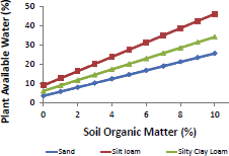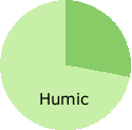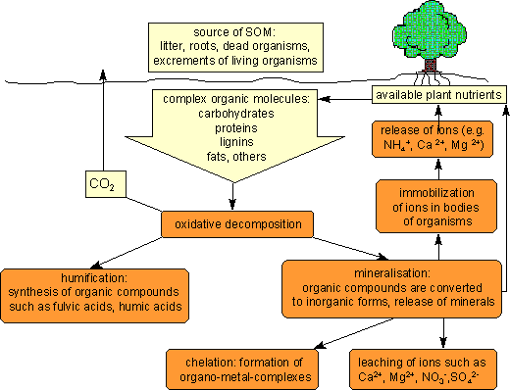6–8 minute read
Structural benefits of compost
Composted organic matter is a uniquely effective soil amendment. Compost binds nutrients, retaining them and thus increasing fertility. In addition, compost transforms the water-handling characteristics of all soil types. Compost creates a range of soil aggregate sizes, resulting in a range of soil pore sizes that provide bulk drainage and channels for plant root water uptake. The mix of pore sizes creates a soil with a granular ped structure that maximizes infiltraton. The increase in storage pores also increases soil available water capacity. In addition, compost itself binds water. Thus, compost improves all three critical properties of soil: available water capacity, infiltration rate, and drainage.
Available water capacity can be more than doubled by the addition of organic matter.
 Northern Colorado Water Conservancy District
Northern Colorado Water Conservancy District
Developing a water-conserving & drought-resistant soil
Composting
Organic matter composition
Humus
Humus is the most reactive and important component of soil organic matter, and is the form typically reported as organic matter in soil tests. Humus consists of old carbon (several hundred years old) and while reactive, is also fully decomposed and stable. It binds inorganic microparticles of sand, silt, and clay together to form microaggregates. Humus benefits soil structure, porosity, and water holding & ion exchange capacities far in excess of its percentage contribution to soil mass. It also helps to chelate mineral elements, creating water-soluble complexes that permit minerals to be mobile in soil and available for plant uptake. Because it is not readily consumed by microorganisms, humus is more resistant to tillage and degradation than active carbon.
Insoluble fraction
Humus contains an insoluble fraction, humin, that is considered to be the key component of fertile soils. Humin improves soil structure, water holding capacity, macroaggregate stability, cation exchange capacity, and fertility.
Soluble fraction
The soluble fraction is composed of humic acids (soluble at low pH) and fulvic acids (soluble at any pH). The main beneficial effect of each is the ability to chelate metals. The proportions of the two acids vary depending on the type of land cover:
 Grassland
Grassland Forest
Forestmodified from the Hungary Digital Textbook Library Distribution of humus forms in grassland & forest soils
Humic acids
Humic acids readily form salts with inorganic trace minerals (micronutrients), converting them to a form that is easily absorbed by plant roots. Humic acids thus increase the efficiency of mineral-based fertilizers.
Fulvic acids
Fulvic acids not only aid mineral absorption by roots, they also facilitate transport within plants, delivering trace minerals directly to the metabolic sites in plant cells. They are key ingredients in high quality foliar fertilizers. Fulvic acids are the most efficient carbon-containing chelating compounds known, possessing more than twice the exchange capacity of humic acids. The relatively small size of fulvic acid chelates lets them readily enter plant stems and leaves in addition to roots. Metal ions that are normally difficult to mobilize or transport within plants, such as iron, are easily moved through plant structures as fulvic acid chelates.
Sources
Source: Humintech
| Humic acids, % | Fulvic acids, % | |
|---|---|---|
| Leonardite/humate Black peat Sapropel peat Dung Compost Soil Sludge | 40 10 10 5 2 1 1 | 85 40 20 15 5 5 5 |
Active carbon
Adapted from OH CES SAG-10-09 The Biology of Soil Compaction
Active carbon (polysaccharides secreted by plant roots and the unique molecule, glomalin) forms part of the glue that binds microaggregates into macroaggregates and then stabilizes the macroaggregates by insulating them from oxygen. Soil porosity, water infiltration, aeration, and structure all benefit from active carbon, and the increased soil macroaggregation also prevents soil particles from compacting. Because active carbon is an energy source for soil microbes, it is not stable like humus and is dramatically decreased by tillage, which oxygenates the soil and increases microbe metabolism.
Glomalin
Glomalin is one of the most important forms of active carbon, coating both plant roots and soil particles. It is created by combining a protein from mycorrhizal fungi with a sugar from plant root exudates. The root-fungal hyphae net creates and stabilizes the macroaggregates, while the clay particles protect the roots and hyphae from attack by microorganisms.
Soil compaction is more than a mechanical issue, it is a biological problem. Relieving compaction requires the restoration of healthy fungal populations in addition to restoration of soil pores. Because glomalin needs to be generated continually to replace what has been consumed, the abundance of macroaggregates is wholly dependent on the presence of healthy mycorrhizal fungus populations.
Organic matter abundance and form
Adapted and expanded from Soil science, Blaskó Lajos, Organic matter, humus, humate, humic acid, fulvic acid, and humin, RE Pettit, Texas A&M University and Soil organic matter, S Grunwald, U of Florida
 FL CES Soil Organic Matter
FL CES Soil Organic Matter
The cycle of organic matter formation and utilization is universal, but local conditions affect the abundance of each component and the rates of each part of the cycle.
Climate
Precipitation and temperature influence vegetation type, abundance, and decomposition rate in predictable ways. Overall, soil organic matter increases with increasing decomposition, up to a limit set by temperature.
Cold or arid climates tend to slow down microbial processes within soil, in particular decomposition and mineralization. Soils in these conditions contain large portions of organic matter as plant debris (macroorganic matter) rather than as humus.
Soil Organic Matter (metric tons / hectare of 1 meter depth)
 modified from FL CES: Soil Organic Matter
modified from FL CES: Soil Organic Matter
Trends occur both west to east and in the eastern US, north to south. Starting on the east side of the Rocky Mountains, soil organic matter increases as precipitation increases. In the eastern US, soil organic matter decreases by ~ 33—50% for every 10°C increase in mean annual temperature).
Land cover
Soils that develop under grass for long periods usually have a relatively high percentage of organic matter in their surface layers, distributed relatively evenly. Soils that develop under trees usually have a low organic matter percentage in their surface layers, which are often mineral soils, but do contain a surface litter layer that is high in organic matter. Organic matter levels are typically higher in a topsoil supporting grasses or forest than in a topsoil used for cultivated crops.


modified from FL CES Soil Organic Matter
Tillage
Soils that are tilled frequently are usually low in organic matter because tilling increases the amount of air in the soil and, therefore, the rate of organic matter decomposition. Loss of organic matter is particularly high in very sandy well-aerated soils because frequent tillage promotes oxidation of organic matter to carbon dioxide, which is then lost to the atmosphere.
Drainage, pH
Soil organic matter is usually higher in poorly-drained or acid soils because of limited oxidation, which slows down the biological decomposition process. However, large portions of the organic matter are plant debris (macroorganic matter) rather than beneficial humus.
Soil texture
Soil organic matter is usually higher in fine-textured soils because soil humus forms stable complexes with clay particles.
